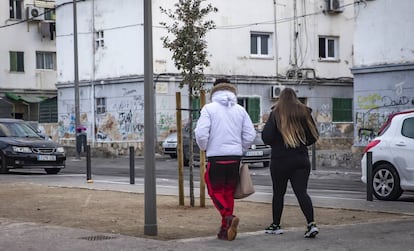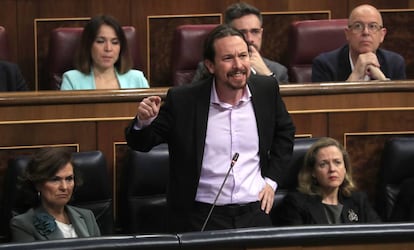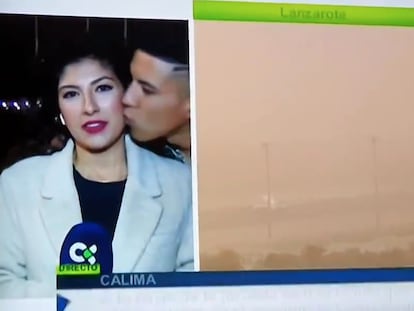How the rape of a 13-year-old in Spain shed light on abuse among at-risk minors
Experts say that young state wards are suffering sexual exploitation, sometimes dragged into the situation by their friends

On Christmas Eve, a 13-year-old girl living in a center for young state wards on the Balearic Island of Palma de Mallorca was the victim of a rape involving six teenagers and a 19-year-old man. How lonely would a girl of that age have to be to escape to nowhere, out on the streets, on December 24?
The police report about a case that has rocked the Spanish islands runs to 114 pages, and explains how the victim asked her psychologist to come with her to a meeting with a friend, but once they got there she ran away. She ended up in a bar, one that last week was lit up with blue neon lights, and is the kind of place you would think twice about entering, especially on Christmas Eve.
A minor who has been the victim of abuse or violence, as many of them have, doesn’t see the signs of riskNoemí Pereda, a specialist in child violence
Once there, the victim was offered money in exchange for sex, according to her testimony, and that’s where her nightmare started. It ended in an apartment in a neighborhood known as Korea. “A minor who has been the victim of abuse or violence, as many of them have, doesn’t see the signs of risk,” explains Noemí Pereda, a specialist in child violence at the University of Barcelona. “They are attracted by the affection, by someone who takes notice of them, that’s their weak point. One might think that because of everything they have been through, in difficult environments, they should be smarter, but they’re not – they’re more fragile,” she adds.
The incident has uncovered a scandal in Spain, of young girls being used as prostitutes and suffering sexual exploitation, sometimes dragged into it by their friends. It’s also uncovered a bigger issue: the problems that exist in the care system for minors – an essential public service where a very difficult job is done, but about which people know very little.
The issue prompted a bitter political debate in Congress earlier this month, as the conservative opposition Popular Party (PP) and far-right Vox criticized the central government for not creating a commission in the Balearic government to investigate the case.
The social educators in Mallorca are very upset about how their work has been disdained. They work in apartments with an average of eight children, and do everything they can to make the lodgings into a home. Above all else, they are sorry about the effect that the case has had on the other kids. “Recently, schoolkids have been saying to the girls from our care homes, ‘Are you a whore? How much do you charge?’” explains Joan Ferrer, the coordinator of the youth facilities on the Balearic Islands.
The Mallorca Institute of Social Affairs (IMAS), which is at the center of the scandal, has stated that it is aware of 16 cases of sexual exploitation of minors in its centers in recent years, some of them prior to their arrival into care. The question now is, how many cases are there in the rest of Spain? None of Spain’s autonomous regions make these figures public.
We know of cases of networks in Murcia, in Seville, in Castellón, in Las Palmas and MadridThe Children’s Ombudsman in the Balearic Islands
A report from the United Nations Children’s Fund (UNICEF), based on more than 300 interviews with educators, supervisors and minors, warned in 2017 that there were cases of sexual exploitation in seven of the nine regions that it studied. It did not say which ones they were. And it warned: “In some cases, there could be evidence that they are captured by networks of people traffickers, who also use them to get into contact with other minors from the center.”
Pereda carried out a study in 2016 in centers in Catalonia and made some surprising findings: many of the minors were still suffering violence and abuse even though they were living in a care home, with the incidents taking place either when they went out or went back to visit their home environments. Just over 9% continued to be victims of sexual abuse and 26% of physical abuse. “There was no work done with the original families, when in theory the aim is for them to return there,” he explains.
It appears that it was an issue that was bound to blow up one day. “Mallorca is not one of the worst places, by any means,” explains Pepa Horno, one of the principal experts in child protection in Spain, and a resident of Palma. “The press has been irresponsible, and the political row [over the Christmas Eve rape] does not help. This is happening all over Spain, but it hasn’t come to light.”
All of the specialists consulted by EL PAÍS say the same thing, pointing to a problem of data and transparency. “We know of cases of networks in Murcia, in Seville, in Castellón, in Las Palmas and Madrid,” warned the Children’s Ombudsman in the Balearic Islands, Serafí Carballo, during a public statement he made last week.
The Balearic regional government, which, like the national government, is run by the Socialist Party (PSOE) and left-wing Unidas Podemos, has rejected putting an investigation in motion, but the controversy has reached Spain’s parliament and Unidas Podemos leader Pablo Iglesias, who is also one of Spain’s deputy prime ministers and the minister for Social Rights, said in the Senate on Tuesday that the Palma case is not an isolated one. “These cases have also taken place in other regions, and I wouldn’t want to think for a minute that when they have taken place in Madrid, the Basque Country and the Canary Islands they were not among your concerns,” he told senators, in reference to regions that are governed by other parties.
In the case of the Mallorca incident, a number of risk factors came together, given that it is a complex society with high levels of youth crime and a lot of tourism
Iglesias also went into detail about a new law to protect children that is being prepared by the PSOE-Unidas Podemos coalition government, which will include new protection protocols in youth care centers, with prevention plans and early detection in cases of trafficking.
“It’s an issue that people are not aware of and no one wants to produce figures about,” says Jorge Fernández del Valle, another of the recognized experts in the field. He says that in the case of the Mallorca incident, a number of risk factors came together, given that it is a complex society with high levels of youth crime and a lot of tourism. He was due to head a commission of experts on the island to tackle the issue but has backed out given the political conflict over the case.

Pepa Horno put together the UNICEF study and is a specialized consultant. She is called on to improve the care facilities, and has audited 91 centers in the whole country. She explains what their main problems are. “The training [for staff] is terrible,” she says. There is no focus on child abuse, nor trauma psychology. “Instead there are outdated models of punishment reinforcement. The model needs to be updated, basing it on creating a link, an attachment,” she insists. But it’s easier said than done. The working conditions of the tutors are often bad, meaning the staff don’t last long in the role. That hinders the establishment of solid adult points of reference for the youngsters. Such jobs usually pay €1,200 a month.
“It’s a tough profession,” explains Horno. “There’s a huge human quality to it, but [the tutors] see so much pain that if they don’t take care of themselves they end up withdrawing. The first year you want to take on the world, but by the fifth you find yourself sinking. That’s why most of [the staff] are very young, they are straight out of school.” Moreover, the bar where the victim in Palma ended up is just five minutes from the apartment where she was living. Oftentimes the location of these care homes is not the most ideal.
Cristina Junquera from UNICEF believes that the 2015 Children’s Law is positive, but that it has been overtaken by reality and must be adapted. “There has been a large increase in children under care,” she says. The latest data from Spain’s Childhood Observatory, which were published in January, are from 2018. Spain has 1,104 care homes, only 216 of which are public, the rest part public, part private. They care for 21,283 minors, the majority of whom, 15,437, are male. In 2014, the total number was 13,563. The number of foreign children under care has also shot up, from 2,974 in 2016 to 10,359 in 2018. For the first time ever, they outnumber Spaniards, accounting for 55% of the total. Of these, 9,506 are unaccompanied minors. The system is overwhelmed and is losing control. Experts point to the Basque Country and Asturias as having the best centers in Spain.
Another recent factor that has influenced the situation is the use of cellphones, which make relationships easier – including the dangerous ones
Catalina Perazzo, from Save the Children, points to another aspect of the 2015 law and European policy: that fostering should be prioritized, but that is also easier said than done. “A child said to me once, ‘They told me my guardian is the Madrid Region. What is that?” This is another basic problem: Spain is the EU country that has the highest number of minors in care centers. In 2018, for the first time ever, the number of minors in these facilities exceeded those placed in foster care.
Another recent factor that has influenced the situation is the use of cellphones, which make relationships easier – including the dangerous ones. It used to be more difficult for adults to get in touch with minors. In Palma, people point to Plaza de España and the bus station as key places for grooming. Groups of minors and adults can be seen loitering there, making for a strange atmosphere come nightfall.
Tutors believe that there aren’t mafias per se, but rather local networks of people who seek out these children, because they know they are the most vulnerable. “They are more at risk, thanks to their experiences and also the circles in which they move sometimes,” explains Fernández del Valle. Care centers are not prisons, and the minors can come and go as they please, as any child of their age can. The first warning sign is when they disappear for hours at a time, ignoring the rules, and return with new cellphones or expensive clothes. And with a phrase they have heard: bring more friends next time.
“In 2005 I was the director of a center and it was happening back then, there have always been abscondments,” explains Marc Tur, who was the head of the Balearic Office for Minors between 2015 and 2016. “You would report it but the police couldn’t do anything else but bring them home. They used to complain, ‘We’re like taxi drivers,’ but they couldn’t do anything else.”
For Pepa Horno, the most decisive factor is working on the trauma of each child. “The therapeutic work involves restoring a porcelain vase that’s been broken into a thousand pieces,” Tur explains. Trauma, for example, causes damage to the brain that can affect attention and memory. “Academic success rates are very low, they find it hard to concentrate and few get as far as university,” explains Ferrer. That said, there are many children who manage to put their lives back together and move on. “There are a lot of people trying to break that chain,” explains Horno. “You are born into a family that does you harm, the center doesn’t help you, and you end up doing damage to others or to yourself.” The protection services often receive the children of people who were themselves under state protection – it’s like a vicious circle.
The other side of the statistics involves the nearly 20,000 foster families who take in minors, who never appear in the media, and in many cases, whose stories end well. Felipe Nóvez, 43, ended up in a care center in Palma between the ages of 11 and 18. “Thanks to the tutors I managed to get out of the world I was living in,” he says. “If not I would have ended up like the rest: in the cemetery or the big house, you know what I mean?” He is now married, has two children and a job. “We are still in touch,” he says of his former carers. “I love them like brothers.”
English version by Simon Hunter.
Tu suscripción se está usando en otro dispositivo
¿Quieres añadir otro usuario a tu suscripción?
Si continúas leyendo en este dispositivo, no se podrá leer en el otro.
FlechaTu suscripción se está usando en otro dispositivo y solo puedes acceder a EL PAÍS desde un dispositivo a la vez.
Si quieres compartir tu cuenta, cambia tu suscripción a la modalidad Premium, así podrás añadir otro usuario. Cada uno accederá con su propia cuenta de email, lo que os permitirá personalizar vuestra experiencia en EL PAÍS.
¿Tienes una suscripción de empresa? Accede aquí para contratar más cuentas.
En el caso de no saber quién está usando tu cuenta, te recomendamos cambiar tu contraseña aquí.
Si decides continuar compartiendo tu cuenta, este mensaje se mostrará en tu dispositivo y en el de la otra persona que está usando tu cuenta de forma indefinida, afectando a tu experiencia de lectura. Puedes consultar aquí los términos y condiciones de la suscripción digital.
More information
Últimas noticias
Most viewed
- Oona Chaplin: ‘I told James Cameron that I was living in a treehouse and starting a permaculture project with a friend’
- Sinaloa Cartel war is taking its toll on Los Chapitos
- Reinhard Genzel, Nobel laureate in physics: ‘One-minute videos will never give you the truth’
- Why the price of coffee has skyrocketed: from Brazilian plantations to specialty coffee houses
- Silver prices are going crazy: This is what’s fueling the rally











































